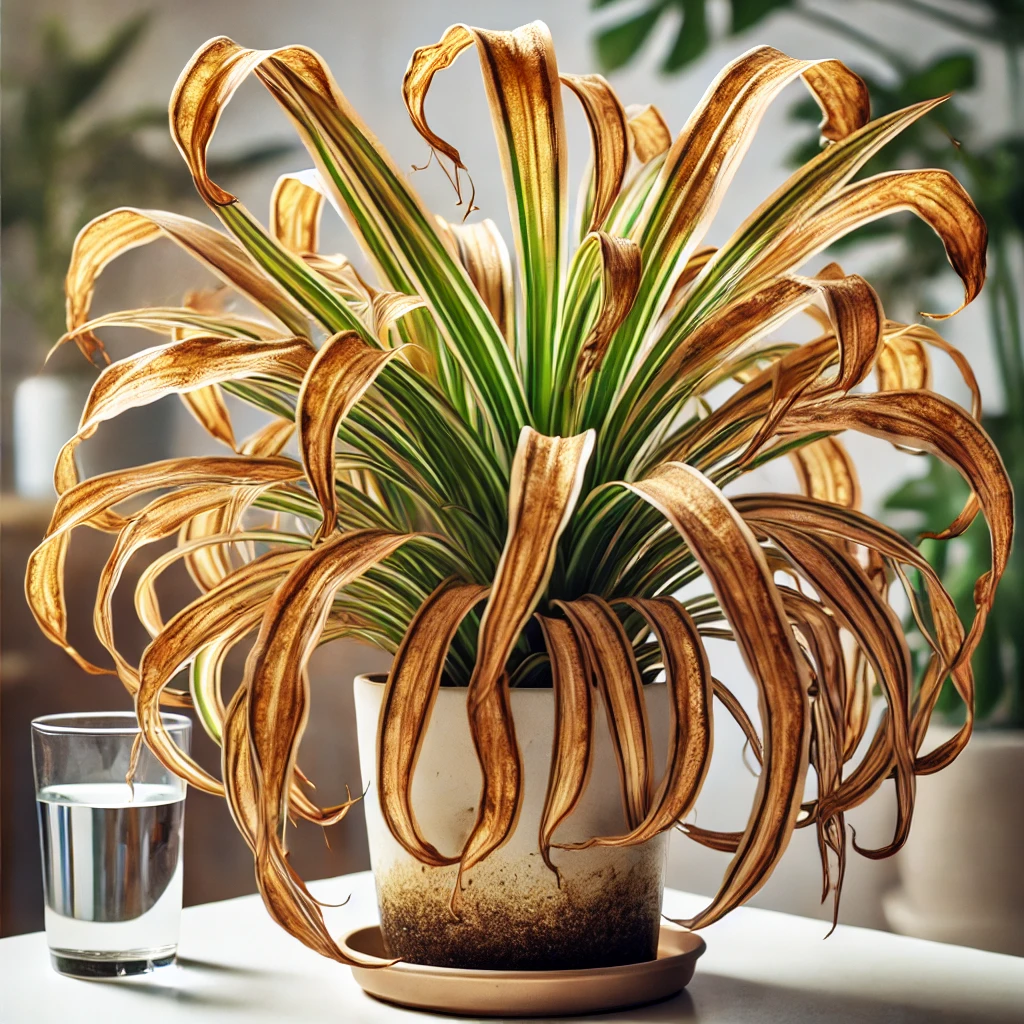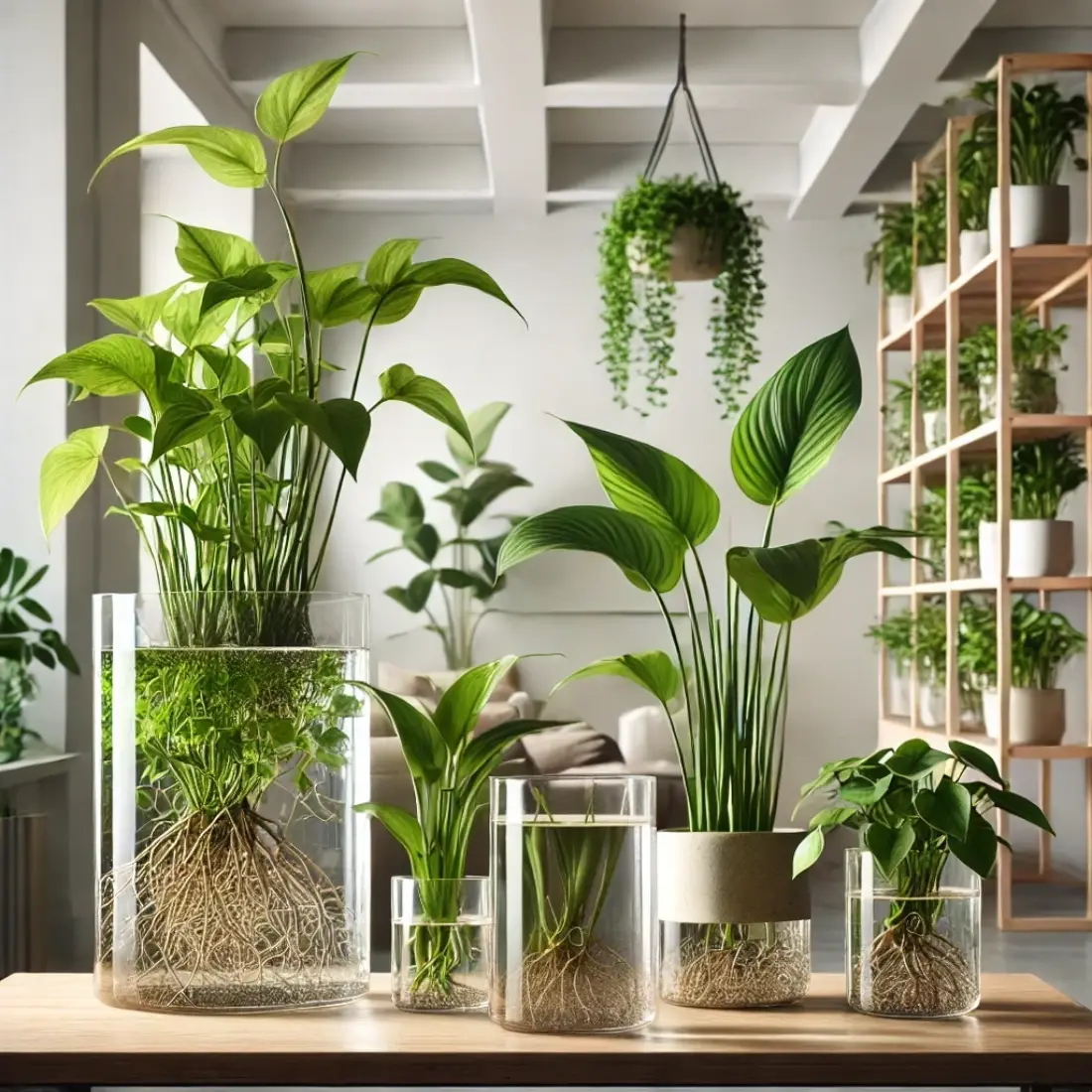Fluoride is commonly added to tap water to promote dental health. While beneficial to humans, fluoride can be toxic to many plants, especially those grown indoors. Over time, this seemingly harmless compound can build up in the soil, leading to browning leaf tips, stunted growth, and even the gradual decline of your beloved greenery.
Certain plants, like Spider Plants and Dracaenas, are particularly sensitive to fluoride, making them more susceptible to damage from regular tap water.
- Fluoride in Tap Water: While fluoride is beneficial for human dental health, it can be harmful to many houseplants, especially those sensitive to fluoride.
- Common Symptoms: Houseplants exposed to fluoride often exhibit brown leaf tips, yellowing, and stunted growth. These symptoms can worsen over time as fluoride accumulates in the soil.
- Sensitive Plants: Some plants, like Spider Plants, Peace Lilies, and Dracaenas, are particularly vulnerable to fluoride toxicity, showing damage more quickly than others.
- Watering Practices: To protect your plants, consider using distilled, rain, or filtered water instead of tap water. Letting tap water sit for 24 hours before use can also help reduce fluoride levels.
- Soil and Fertilizer Choices: Use well-draining soil and fluoride-free fertilizers to minimize fluoride buildup in the soil.
Which Houseplants are Most Sensitive to Fluoride?
Certain houseplants are particularly sensitive to fluoride and are more likely to show signs of damage when watered with fluoridated tap water. Among the most susceptible are:
- Spider Plants (Chlorophytum comosum): Known for their graceful arching leaves, Spider Plants are highly sensitive to fluoride. They often develop brown leaf tips and edges, a common symptom of fluoride toxicity.
- Peace Lilies (Spathiphyllum spp.): Peace Lilies are popular for their ability to thrive in low light, but they can suffer from fluoride damage, leading to browning and yellowing of the leaves, particularly at the tips.
- Dracaenas (Dracaena spp.): This group of plants, which includes the popular Dracaena marginata and Dracaena fragrans, is highly susceptible to fluoride. They tend to develop yellow or brown tips, and their overall growth may be stunted over time.
- Parlor Palm (Chamaedorea elegans): A popular indoor palm, the Parlor Palm can also suffer from brown tips and leaf damage due to fluoride in the water.
- Cordylines (Cordyline spp.): These plants are often used for their striking foliage, but they too can exhibit brown tips and discoloration when exposed to fluoride.
For these plants, it’s crucial to use fluoride-free water or implement methods to reduce fluoride levels in tap water.
How to Test Tap Water for Fluoride Levels
Before taking action, it’s important to know the fluoride levels in your tap water. Here’s how you can test it:
- Home Testing Kits: Affordable and easy to use, these kits can provide a basic measure of fluoride in your tap water. Follow the instructions on the kit carefully for accurate results.
- Professional Testing: For a more precise analysis, consider sending a water sample to a laboratory. Many water testing services will check for fluoride levels along with other potential contaminants.
- Check Local Water Reports: Many municipalities provide annual water quality reports that include fluoride levels. This information can be found online through your local government or water provider’s website.
Best Practices for Watering Houseplants with Tap Water
If your tap water contains fluoride, consider these practices to reduce the risk of damage to your houseplants:
Let Tap Water Sit: Allow tap water to sit out in an open container for 24 to 48 hours before using it on your plants. This waiting period allows some chemicals, like chlorine, to evaporate, though fluoride does not evaporate as readily. While not a complete solution, it can still help reduce overall chemical exposure.
Use Alternative Water Sources: Consider using distilled water, rainwater, or filtered water for your houseplants. These alternatives are free of fluoride and other chemicals that may harm sensitive plants.
- Distilled Water: Readily available and safe for plants, it’s a good option, though it can be costly if used regularly.
- Rainwater: Collecting rainwater is an eco-friendly option that provides pure, fluoride-free water. Be sure to store it properly to avoid contamination.
- Filtered Water: If using tap water, consider a water filter designed to remove fluoride. Not all filters do this, so look for those specifically labeled for fluoride removal.
Mix Watering Sources: If alternative water sources aren’t always available, mix them with tap water to dilute the fluoride content.
Flushing and Leaching Techniques to Reduce Fluoride Build-up
Over time, fluoride can build up in the soil, leading to toxicity even in plants that are moderately tolerant. Flushing and leaching are effective ways to reduce this buildup:
Flushing the Soil: Periodically, flush your plant’s soil by watering thoroughly until water flows out of the drainage holes. This process helps wash away accumulated fluoride and other salts.
- How Often?: For plants sensitive to fluoride, aim to flush the soil every 4 to 6 weeks. For less sensitive plants, flushing every 2 to 3 months should suffice.
- What Water to Use?: Use fluoride-free water, such as distilled or rainwater, to avoid adding more fluoride during the flushing process.
Leaching Techniques: Leaching is similar to flushing but involves more thorough watering over a longer period. This technique is particularly useful if you suspect significant fluoride buildup.
Steps:
- Water the plant until the soil is fully saturated.
- Allow it to drain completely.
- Repeat the process 2-3 times in one session to effectively leach out fluoride.
Frequency: Leaching should be done 2 to 3 times a year for sensitive plants.
Soil and Potting Mix Considerations
Soil quality and composition play a significant role in how much fluoride your plants can tolerate. Consider the following:
- Well-Draining Soil: Use a well-draining potting mix to prevent fluoride accumulation in the soil. This type of soil allows excess water—and the fluoride it contains—to drain away more easily, reducing the risk of buildup.
- Avoid Soil with High Perlite Content: Perlite is a common additive in potting mixes that can increase fluoride levels in the soil. Opt for mixes with lower perlite content or use alternatives like pumice or vermiculite.
- Soil Amendments: Adding organic matter like compost or peat moss to the soil can help buffer the effects of fluoride, as these materials can bind to fluoride ions and reduce their availability to plants.
- Maintain Proper pH Levels: Fluoride toxicity is more likely in acidic soils (low pH). Test your soil’s pH and aim to keep it slightly acidic to neutral (around 6.0 to 7.0) to minimize fluoride uptake by plants.
FAQs About Fluoride and Houseplants
How does fluoride get into tap water?
Fluoride is added to tap water by many municipalities to help prevent tooth decay. It’s also naturally present in some water sources due to the erosion of natural deposits of fluoride-containing minerals.
What are the first signs of fluoride damage in houseplants?
The earliest signs of fluoride damage in houseplants include brown tips on leaves, yellowing, and stunted growth. These symptoms typically appear on the oldest leaves first.
Can all houseplants be affected by fluoride?
While all plants can potentially be affected by fluoride, certain houseplants like Spider Plants, Peace Lilies, and Dracaenas are more sensitive and show symptoms of fluoride toxicity more readily.
Is it safe to use tap water for all my houseplants?
Tap water can be used for most houseplants, but for those sensitive to fluoride, it’s better to use distilled, rainwater, or filtered water to avoid damage.
Can I remove fluoride from tap water by boiling it?
No, boiling water does not remove fluoride. In fact, boiling may concentrate fluoride levels as water evaporates. Instead, use water filters designed to remove fluoride or opt for distilled water.
How often should I flush my houseplants’ soil to remove fluoride?
For fluoride-sensitive plants, you should flush the soil every 4 to 6 weeks with fluoride-free water. Less sensitive plants may only need flushing every 2 to 3 months.
Is there a way to test if my houseplant is suffering from fluoride toxicity?
Yes, visual symptoms like brown leaf tips and stunted growth can indicate fluoride toxicity. A soil test can also confirm the presence of high fluoride levels, and water testing can reveal if your tap water is the source.
Are there any household filters that remove fluoride from tap water?
Yes, certain types of water filters, such as reverse osmosis systems and specific activated alumina filters, are effective at removing fluoride from tap water.
Can rainwater always be used as a safe alternative to tap water for plants?
Generally, yes. Rainwater is free of fluoride and other chemicals found in tap water, making it safe for most houseplants. However, ensure that the collection and storage methods are clean to avoid contamination.
What can I do if my houseplant shows signs of fluoride damage?
If you notice signs of fluoride damage, start using fluoride-free water immediately, flush the soil to remove any accumulated fluoride, and consider repotting the plant with fresh, well-draining soil.











